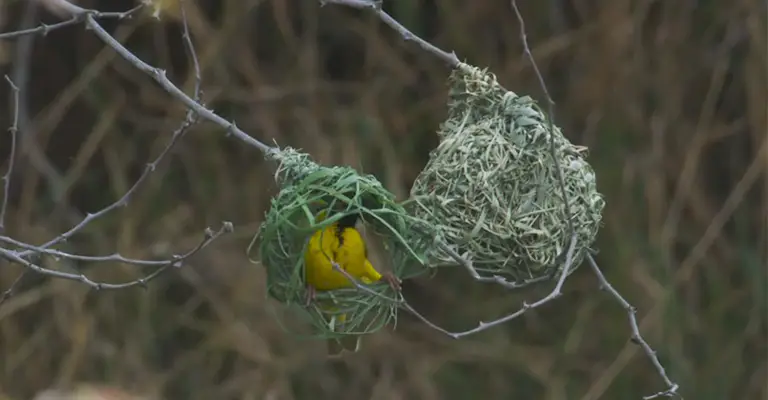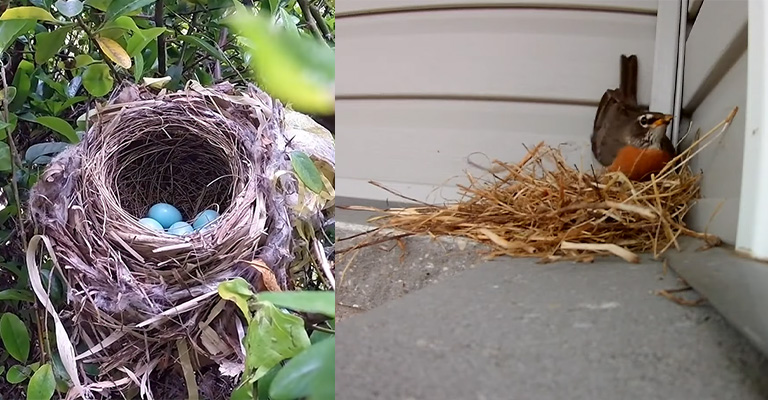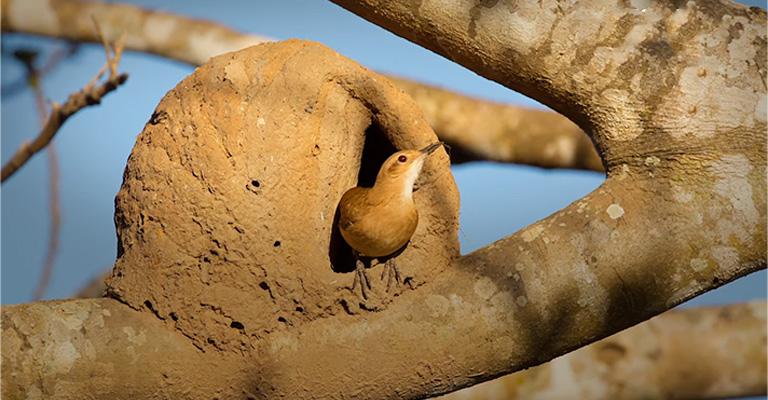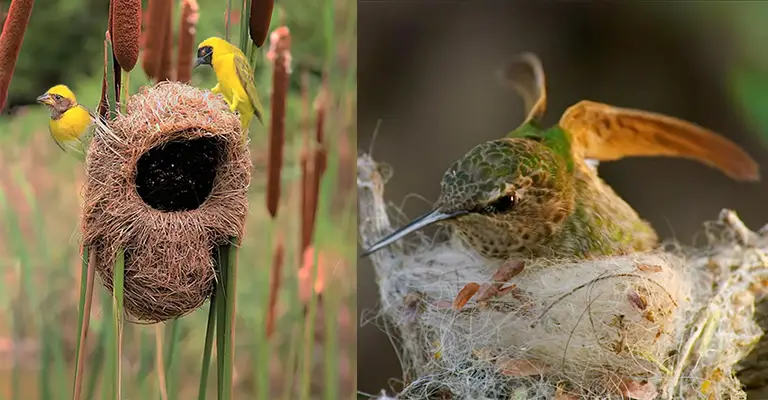In the realm of avian wonders, the art of nest building stands as a testament to the ingenuity and resourcefulness of our feathered friends.
From the intricate woven structures of weaverbirds to the cozy burrows of puffins, birds employ a remarkable array of techniques to construct their homes.
But how do birds build nests? Join us on a captivating journey as we delve into the fascinating world of avian architecture.
In this exploration, we will unravel the secrets behind the materials birds choose, the construction methods they employ, and the remarkable adaptations that enable them to create safe havens for their offspring.
Prepare to be amazed by the remarkable feats of engineering and instinctual brilliance that birds exhibit as they craft their nests.

How Do Birds Build Nests?
Birds build nests using a variety of materials and techniques, depending on the species. Here is a general overview of how birds typically build nests:
Site Selection
Birds choose a suitable location for their nest, which can vary depending on the species. Some birds prefer trees or shrubs, while others build nests on the ground, cliffs, or even man-made structures like buildings or bridges.
Gathering Materials
Birds collect various materials to construct their nests. Common materials include twigs, leaves, grass, moss, feathers, and even spider webs. Some birds may also use mud, rocks, or other items to reinforce the structure.
Framework Construction
Birds start by creating a basic framework for their nests. They often use twigs or small branches as a foundation, arranging them in a circular or cup shape. The framework provides the initial structure and stability for the nest.
Nest Lining
Once the framework is in place, birds add a lining to make the nest more comfortable and suitable for incubating eggs. This lining can consist of softer materials like grass, leaves, feathers, or fur.
Nest Shaping
Birds use their bodies to shape the nest, pressing and molding the materials into the desired form. They may use their beaks, feet, or wings to arrange and compact the materials, ensuring the nest is secure and well-constructed.
Nest Maintenance
Throughout the nesting period, birds may continue to add materials to the nest or make repairs as needed. This helps to maintain the nest’s structural integrity and ensure it remains suitable for incubating eggs and raising chicks.
It’s important to note that different bird species have unique nest-building behaviors and preferences. Some birds build elaborate structures, while others create simple nests.
Different Types of Bird Nests

Birds build a wide variety of nests, each suited to their specific needs and habitats. Here are some examples of different types of bird nests:
Cup Nests
Cup nests are the most common type of bird nest. They are shaped like a cup or bowl and are typically made of twigs, grass, leaves, and other plant materials. Examples of birds that build cup nests include robins, sparrows, and warblers.
Platform Nests
Platform nests are flat and often built on a horizontal surface, such as tree branches or cliffs. They are constructed using sticks, twigs, and other materials. Ospreys and eagles are known for building large platform nests.
Burrow Nests
Some birds, like burrowing owls and kingfishers, excavate burrows in the ground to create their nests. These nests provide protection from predators and the elements.
Cavity Nests
Cavity nests are built inside tree cavities, holes in cliffs, or man-made structures like birdhouses. Woodpeckers, owls, and bluebirds are examples of birds that use cavity nests. They often line the cavities with softer materials like feathers or moss.
Pendulous Nests
Pendulous nests are suspended from tree branches and hang down like a pouch. They are typically woven using grass, plant fibers, and spider webs. Orioles and weaverbirds are known for building pendulous nests.
Mound Nests
Mound nests are constructed by piling up materials like sticks, leaves, and mud into a mound or platform. They are often found in wetland areas and are built by birds like flamingos and grebes.
Floating Nests
Some birds, such as grebes and coots, build floating nests on the water’s surface. They use aquatic vegetation and other buoyant materials to create a platform that supports the nest.
These are just a few examples of the diverse range of bird nests. Each species has its own unique nest-building behavior and preferences, adapting to its specific ecological niche and environmental conditions.
Where Do Birds Build Their Nest?

Birds build their nests in a variety of locations, depending on their species and habitat preferences. Here are some common places where birds build their nests:
Trees and Shrubs
Many bird species construct their nests in trees and shrubs. They may choose the branches, forks, or crooks of tree trunks as suitable locations. Examples include robins, sparrows, and warblers.
Ground
Some birds, such as shorebirds and gamebirds, build their nests on the ground. They create shallow depressions in grass, vegetation, or soil to lay their eggs and raise their young.
Cliffs and Rocky Ledges
Birds like eagles, falcons, and seabirds often build their nests on cliffs and rocky ledges. These locations provide protection from predators and offer a vantage point for hunting or observing their surroundings.
Cavity or Hollow Structures
Many bird species utilize cavities or hollow structures for nesting. They may use natural tree cavities, holes in cliffs, or even man-made structures like birdhouses or abandoned buildings. Woodpeckers, owls, and bluebirds are known for using cavities for nesting.
Wetlands
Birds that inhabit wetland areas, such as marshes or swamps, often build their nests in vegetation or floating platforms. They may construct nests among reeds, cattails, or floating vegetation. Examples include herons, ducks, and grebes.
Human-made Structures
Some bird species have adapted to urban environments and built their nests on man-made structures. They may use buildings, bridges, or even streetlights as nesting sites. Pigeons and swallows are common examples of birds that nest in urban areas.
Note that the specific nesting locations can vary greatly depending on the bird species and their ecological requirements. Birds select nesting sites that provide safety, protection from the elements, and easy access to food sources for themselves and their offspring.
What Are Some Common Bird Nesting Techniques?

The nesting behavior of birds is fascinating and varies greatly across species, reflecting their adaptations to different environments and lifestyles. Here are a few nesting techniques used by birds:
Platform with Mud
Birds like swallows and martins construct cup-shaped nests using mud. They collect wet mud and shape it into a cup, attaching it to a vertical surface like a wall or cliff.
Hanging Basket
Some birds, such as the golden oriole, build intricate hanging basket nests. They weave together long grasses, plant fibers, and other flexible materials to create a deep, basket-like structure suspended from tree branches.
Raft Nest
Certain bird species, like the common coot, build nests that float on the water’s surface. They gather aquatic vegetation and create a floating platform, securing it to vegetation or other structures in the water.
Colony Nesting
Many bird species, including gulls and terns, nest in large colonies. They build nests close to each other, often on the ground or cliffs, creating a dense nesting area that provides protection against predators.
Host Parasitism
Some birds, like the cuckoo, employ a parasitic nesting strategy. They lay their eggs in the nests of other bird species, leaving the host birds to incubate and raise their chicks.
Nesting Platforms
Birds like the osprey and eagle construct large nests on elevated platforms specifically built for them. These platforms are often placed on tall structures, such as poles or towers, providing a safe and stable nesting site.
Floating Mat
Certain bird species, such as the red-necked grebe, create floating mats made of vegetation. They gather aquatic plants and interweave them to form a floating platform on which they build their nests.
Rock Crevices
Birds like the peregrine falcon and rock dove nest in natural rock crevices or cliff ledges. These nests provide protection and camouflage, as well as a secure foundation for their eggs.
Ground Scrapes
Some bird species, such as the killdeer, create simple nests known as ground scrapes. They scrape away vegetation and debris to create a shallow depression in the ground, often lined with pebbles or shells.
FAQs
Birds choose nesting sites based on various factors, including the availability of suitable materials, protection from predators, proximity to food sources, and shelter from the elements. They often select locations that provide safety and meet their specific habitat requirements.
Some bird species reuse their nests, while others build new ones each breeding season. Birds that build sturdy nests, such as eagles and hawks, may reuse them for several years with occasional repairs.
The time it takes for birds to build a nest varies depending on the species and the complexity of the nest. Some birds can construct a simple nest in just a few days, while others may take several weeks to build more elaborate structures.
In many bird species, both male and female birds participate in nest building. They work together to gather materials, construct the nest, and make repairs as needed.
After the breeding season, bird nests may serve different purposes. Some nests are abandoned and left to deteriorate over time. Others may be reused by other bird species or repurposed by animals like squirrels.
Final Words
As we conclude our exploration into the captivating world of bird nest building, we are left in awe of the remarkable abilities and instincts possessed by these feathered architects.
From the meticulous selection of materials to the intricate construction techniques, birds demonstrate an innate understanding of their environment and the needs of their young.
The diversity of nest designs across different species highlights the adaptability and creativity of these avian builders.
While we continue to study and appreciate the art of nest building, let us marvel at the ingenuity and resourcefulness of these remarkable creatures.
May this newfound knowledge deepen our admiration for the wonders of the natural world and inspire us to protect and preserve the habitats that birds rely on for their remarkable architectural endeavors.